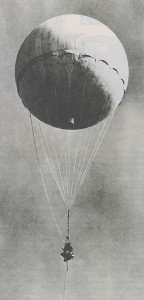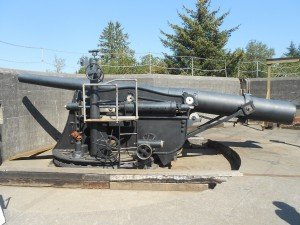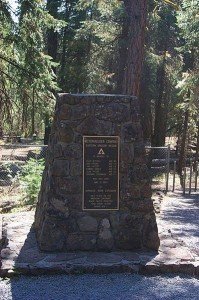
World War Two is often times considered an event that occurred many miles away from the shores of North America. For the most part this is correct. German U-Boats operated not far off the shores of America and did indeed inflict damage to Allied merchant shipping. The action in the Gulf of Mexico is a prime example. Action off the east coast of the United States is another good example. What about the west coast of the U.S.? Did Japanese submarines lurk there as well? The answer is yes. Was damage caused along the U.S. west coast? The answer again is yes although the Japanese activity there could be classified as more of a harassment operation rather than something of a tactical nature.
The Japanese Balloon Bomb

One element of this harassment actually didn’t originate from a submarine but rather from mainland Japan itself. This involved a weapon known as the “fire balloon” or “Balloon Bomb“. It’s a fact that the Japanese actually used balloons in warfare since the 1800’s. These devices were constructed of “washi“, a paper obtained from mulberry bushes that was considered impermeable and extremely tough. These were hydrogen filled balloons carrying a charge of perhaps a 33 lb antipersonnel bomb. Other charges carried may have been a 26 lb incendiary device. These balloon bombs were built at many locations throughout Japan.
The balloon’s direction was at the mercy of the jet stream which was most favorable during the winter months. Because of this, the first balloon was launched from Japan in November of 1944. Based on the jet stream speed it was anticipated that the fire balloon would travel for about three days before reaching the U.S. west coast. The balloons were equipped with a control system that operated the balloon bomb through three days of flight. It was figured that by that time the balloon would likely be over the United States. After three days aloft the balloon’s ballast was expended.
Why a Fire Balloon?
The question was…why a fire balloon? Why attack the U.S. west coast with a balloon bomb? Also, what was the goal of this weapon? Could this long distance weapon possibly be intended to change the course of World War Two? It has been estimated that about 9,300 of these balloons were launched by Japan between November 1944 and April 1945. This was during the latter part of the war and at a time when Japan was slowly but surely on the losing side. Out of this very large number of fire balloons launched, some three hundred were observed over the western U.S. Over the years after the war, several of these devices were discovered. Eight balloons were found during the 1940’s, three during the 1950’s and two in the 1960’s. Parts of one balloon were also found as late as 1978. Japanese Fire Balloons were found as far east as the state of Michigan.

One goal of the Japanese fire balloon campaign appeared to be to start forest fires, particularly in the Pacific Northwest. Their stated aim was also to “destroy” U.S. and Canadian cities in North America which seems to be a long shot at best since the steering of the devices were left to the whims of the jet stream. As late in the war that this occurred, it would be outlandish to think that the course of the war could be altered by the balloon bomb campaign. The several small forest fires that did occur because of the fire bombs were quickly put out. Nothing strategically was accomplished by the fire bomb effort.
Two additional articles with photos on our Western Trips site you’ll be interested in are the Defense of San Francisco Bay and the USS Pampanito Submarine.
Fatalities in the United States
Outside of the fire balloon attacks, the Japanese offensive on the U.S. west coast caused little damage. Attacks did include a submarine shelling of an oil platform just off Santa Barbara California, a night time attack on Fort Stevens at the mouth of the Columbia River in Oregon and an attack by a very small aircraft launched from a Japanese submarine.

One very unfortunate incident that occurred on May 5, 1945 did involve a balloon bomb that had landed in a southern Oregon forest. A group of adults and children headed out for a picnic and while looking for a suitable site discovered a balloon on the forest floor. Part of the group approached the balloon and as they did it exploded. The result was that five children and a pregnant woman were killed. Records indicate that this was the only fatal incident involving Japanese fire balloons launched against North America. The photo at right is of the “Mitchell Monument” located in the Fremont-Winema National Forest near Bly Oregon where the wife of Reverend Archie Mitchell and five Sunday school children were killed in 1945.
What the Public Knew.
Much has been written about what the public did and did not know about the Japanese fire balloon bomb program. When Japan began sending fire balloons eastward toward the U.S. there was not a lot press about the subject. One reason could have been concerning perceived Japanese experiments with biological warfare. Another was that the American military didn’t want to broadcast to the Japanese that indeed some balloons actually did reach North America. Although the effectiveness of the balloon campaign was quite low, why publicize anything about them to the Japanese. Why have the enemy learn through the media just where some of these balloons have landed? Publicity could only encourage a continuation of the program and possibly excite the population on the west coast as well.

As a result, the Office of Censorship asked the media to refrain from reporting on the balloon bombs. After the deaths in Oregon, the government lifted the censorship. If for no other reason to warn people of the potential dangers if another one was discovered. Some thought that it was wrong for the military to cover up the balloon attacks since knowledge of it by the public could have prevented the unfortunate Oregon fatalities.
Interestingly enough, some in the public actually thought that the balloons were launched from U.S. soil, possibly from beaches along the west coast where submarines landed launching parties. Some believed it impossible that the balloons could travel that far from the Japanese mainland. This launching from U.S. beaches was very unlikely and there has never been any evidence found whatsoever that balloons were launched from American soil.
Exhibits of the Japanese Fire Balloon
Parts of Japanese Fire Balloons or Balloon Bombs that were found in Oregon in 1978 are exhibited at the Coos Historical and Maritime Museum. The museum is located at 1220 Sherman Avenue, North Bend Oregon. The museum is operated by the Coos County Historical Society. Founded in 1891 as the “Coos County Pioneer Association”, it is considered the second oldest historical society in the State of Oregon.
An excellent book on the subject of the Japanese Balloon Bombs is The Cloud Atlas by author Liam Callanan.
